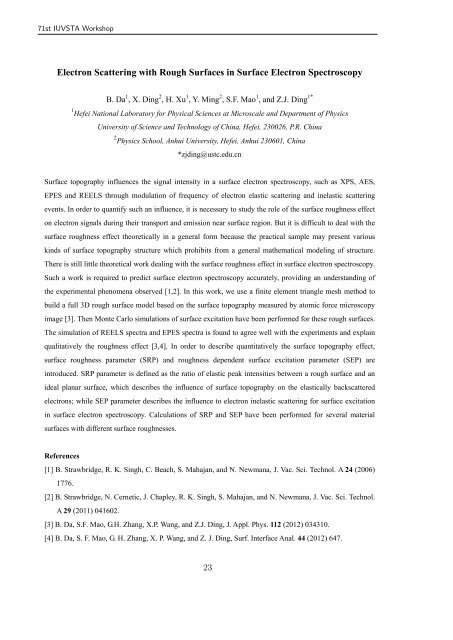Untitled - IAP/TU Wien - Technische Universität Wien
Untitled - IAP/TU Wien - Technische Universität Wien
Untitled - IAP/TU Wien - Technische Universität Wien
Create successful ePaper yourself
Turn your PDF publications into a flip-book with our unique Google optimized e-Paper software.
71st IUVSTA Workshop<br />
Electron Scattering with Rough Surfaces in Surface Electron Spectroscopy<br />
B. Da 1 , X. Ding 2 , H. Xu 1 , Y. Ming 2 , S.F. Mao 1 , and Z.J. Ding 1*<br />
1 Hefei National Laboratory for Physical Sciences at Microscale and Department of Physics<br />
University of Science and Technology of China, Hefei, 230026, P.R. China<br />
2 Physics School, Anhui University, Hefei, Anhui 230601, China<br />
*zjding@ustc.edu.cn<br />
Surface topography influences the signal intensity in a surface electron spectroscopy, such as XPS, AES,<br />
EPES and REELS through modulation of frequency of electron elastic scattering and inelastic scattering<br />
events. In order to quantify such an influence, it is necessary to study the role of the surface roughness effect<br />
on electron signals during their transport and emission near surface region. But it is difficult to deal with the<br />
surface roughness effect theoretically in a general form because the practical sample may present various<br />
kinds of surface topography structure which prohibits from a general mathematical modeling of structure.<br />
There is still little theoretical work dealing with the surface roughness effect in surface electron spectroscopy.<br />
Such a work is required to predict surface electron spectroscopy accurately, providing an understanding of<br />
the experimental phenomena observed [1,2]. In this work, we use a finite element triangle mesh method to<br />
build a full 3D rough surface model based on the surface topography measured by atomic force microscopy<br />
image [3]. Then Monte Carlo simulations of surface excitation have been performed for these rough surfaces.<br />
The simulation of REELS spectra and EPES spectra is found to agree well with the experiments and explain<br />
qualitatively the roughness effect [3,4]. In order to describe quantitatively the surface topography effect,<br />
surface roughness parameter (SRP) and roughness dependent surface excitation parameter (SEP) are<br />
introduced. SRP parameter is defined as the ratio of elastic peak intensities between a rough surface and an<br />
ideal planar surface, which describes the influence of surface topography on the elastically backscattered<br />
electrons; while SEP parameter describes the influence to electron inelastic scattering for surface excitation<br />
in surface electron spectroscopy. Calculations of SRP and SEP have been performed for several material<br />
surfaces with different surface roughnesses.<br />
References<br />
[1] B. Strawbridge, R. K. Singh, C. Beach, S. Mahajan, and N. Newmana, J. Vac. Sci. Technol. A 24 (2006)<br />
1776.<br />
[2] B. Strawbridge, N. Cernetic, J. Chapley, R. K. Singh, S. Mahajan, and N. Newmana, J. Vac. Sci. Technol.<br />
A 29 (2011) 041602.<br />
[3] B. Da, S.F. Mao, G.H. Zhang, X.P. Wang, and Z.J. Ding, J. Appl. Phys. 112 (2012) 034310.<br />
[4] B. Da, S. F. Mao, G. H. Zhang, X. P. Wang, and Z. J. Ding, Surf. Interface Anal. 44 (2012) 647.<br />
23
















